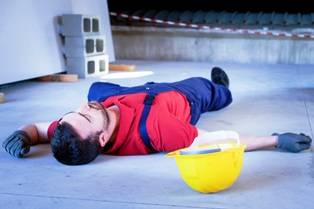 According to the Occupational Health and Safety Administration (OSHA), falls are the leading cause of injury and death on construction sites. It is the responsibility of the contractors and subcontractors on a site to provide a safe work environment, including fall prevention measures. When these protections are not in place and you are injured in a fall, you may be able to recover damages from one of the contractors on the site, if not your direct employer.
According to the Occupational Health and Safety Administration (OSHA), falls are the leading cause of injury and death on construction sites. It is the responsibility of the contractors and subcontractors on a site to provide a safe work environment, including fall prevention measures. When these protections are not in place and you are injured in a fall, you may be able to recover damages from one of the contractors on the site, if not your direct employer.
Who Is Responsible for Compensating You?
Under workers’ compensation law in Pennsylvania, your medical bills will be paid by your employer’s workers’ comp insurance when you are injured on the job. The law also prohibits injured employees from suing their employers for damages. Even if your direct employer was the one responsible for providing fall protection and failed to do so, you will not be able to sue him for damages. However, if another contractor on the site—such as an electrical, roofing, or plumbing subcontractor—was responsible for the safety of those working in a particular area and their oversight led to your injury, you may be able to sue that subcontractor for damages beyond what you will get from workers’ comp.
Fall Protection Measures That Should Be in Place
As a construction worker on a job site, you are entitled to work in safe conditions. As falls are the leading cause of death on construction sites, some of the protections that should be in place include the following:
- Personal fall arrest equipment. These systems consist of lanyards, harnesses, and anchorage devices that are used when other fall prevention systems cannot be used. Anchoring a worker to a fixed object when he or she is working at extreme heights will prevent a catastrophic fall.
- Clean work areas. High traffic areas must be kept clear of hazards, such as tools, spilled liquids, and other debris to prevent workers from tripping and falling. The contractor responsible for keeping the area in question tidy would be responsible for anyone injured because of the hazard.
- Guardrails and handrails. Any elevated work surface—such as scaffolding, ramps, or platforms—should be bordered by sturdy rails. Likewise, holes and other openings should be surrounded by guardrails.
- Safety nets. In high-risk work areas where other measures are not feasible, safety nets may need to be installed below. While not an ideal solution, nets can prevent deaths on construction sites
Why You Need a Construction Accident Attorney
If you are injured on a construction site, you will likely be told by your employer that workers’ compensation is the only compensation you are entitled to. However, our attorneys will be able to determine if there is another liable party who may be responsible for your damages. Call us as soon as possible after your accident so we can get to work for you.
